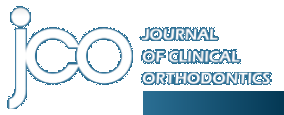Search Results For: 'orthodontics'
3821.
Correction of Mesially Impacted Lower Second and Third Molars
Volume 21 : Number 3 : Page 0 : Mar 1987
Mesial impaction of lower second or third molars is a frequent clinical problem. Further, the extraction of lower second molars to relieve crowding is a common practice that often results in mesially ...
3822.
Effects of Reduced Acid Concentration and Etching Time on Bond Strength and Enamel Morphology
Volume 21 : Number 6 : Page 0 : Jun 1987
The acid-etch bonding technique has been used extensively since its introduction by Buonocore in 1955.1 Plastic and metal brackets were introduced specifically for attachment to the acid-conditioned e...
3823.
Volume 22 : Number 8 : Page 0 : Aug 1988
Topics are fiberotomy and staff uniforms.1. How often do you recommend supracrestal fiberotomy procedures? For which teeth?There was considerable diversity among the respondents. Only 3% reported rout...
3824.
The Effect of Silane Coupling Agents on the Bond Strength of a Polycrystalline Ceramic Bracket
Volume 22 : Number 12 : Page 0 : Dec 1988
Although the size, shape, prescription, and bulk of metal and synthetic sapphire (ceramic) brackets are similar, there is an important difference that can affect bond strength: the process required to...
3825.
Semi-Indirect Bonded Lingual Retainer
Volume 23 : Number 3 : Page 0 : Mar 1989
Many kinds of orthodontic corrections--for instance, alignment of rotated teeth--require long periods of retention. A number of bonded retainers have been developed for long-term use.1-6 I have devise...
3826.
Assessment of Mesiodistal Axial Inclination through Panoramic Radiography
Volume 24 : Number 3 : Page 0 : Mar 1990
A major objective of orthodontic treatment is the normalization of tooth positions in three planes of space, with the goal of approaching predefined cephalometric or occlusal standards.1-7 One of the ...
3827.
Vertical Control with a Headgear-Activator Combination
Volume 24 : Number 10 : Page 0 : Oct 1990
One of the major complaints about activator therapy is the lack of control of lower facial height. Combining the activator with a headgear is a solution that has been proposed by several authors to op...
3828.
Modified Nance Appliance for Unilateral Molar Distalization
Volume 26 : Number 7 : Page 0 : Jul 1992
Unilateral Class II patients have been treated with specialized headgears, unilateral Class II elastics, and various types of removable appliances that not only require cooperation, but may tax valuab...
3829.
Stereometric Evaluation of the Enamel-Stripping Effect of Hydrochloric Acid
Volume 26 : Number 12 : Page 0 : Dec 1992
Enamel demineralization in the form of white spots is often seen following the removal of orthodontic appliances.1,2 The maxillary lateral incisors and canines are most often involved (Fig. 1).3,4 Dem...
3830.
Indirect Bonding with Adhesive Precoated Brackets
Volume 27 : Number 3 : Page 0 : Mar 1993
Adhesive precoated (APC) brackets have a number of clinical advantages, including consistency and accuracy of positioning, ease of placement, and reduction of chairtime.1 They can be bonded indirectly...
3831.
Simultaneous Torquing and Intrusion Auxiliary
Volume 27 : Number 6 : Page 0 : Jun 1993
Several different orthodontic approaches have evolved for intrusion of the maxillary incisors.1-4 Whatever method is used, the control and stabilization of posterior anchorage is imperative, since inc...
3832.
Plasticization of Adhesive to Improve Debonding of Ceramic Brackets
Volume 27 : Number 6 : Page 0 : Jun 1993
Problems such as bracket fracture and enamel fracture and "crazing" have been reported in debonding ceramic brackets. These problems occur because all three components of the system-- the bracket, the...
3833.
CASE REPORT
Combined Fixed-Functional Class II Treatment
Volume 28 : Number 1 : Page 0 : Jan 1994
Class II, division 1 and 2 cases often involve both dental and skeletal problems. Functional appliances have been shown to produce beneficial effects in growing patients with Class II malocclusions, b...
3834.
Volume 28 : Number 8 : Page 0 : Aug 1994
My orthodontic practice is like many others in that we have gradually improved our quality of management over the past 20 years. Through information from journals, consultants, and other offices, we h...
3835.
Maxillary Second Molar Extraction Treatment
Volume 28 : Number 8 : Page 0 : Aug 1994
Maxillary second molars are not often extracted in place of the more usual premolars. However, Graber recommends this approach in Class II, division 1 cases with excessive labial inclination of the ma...
3836.
THE EDITOR'S CORNER
Volume 29 : Number 7 : Page 0 : Jul 1995
First Things First Shortly before he died, my friend and TMD mentor, Welden Bell, counseled a young oral surgeon who was having an unusually difficult time resolving a patient's TMD. The surgeon expla...
3837.
Volume 29 : Number 12 : Page 0 : Dec 1995
The Edgewise Herbst Appliance is designed to minimize certain limitations inherent in the Herbst design and to incorporate edgewise brackets and mechanics in the correction of Class II malocclusions. ...
3838.
Volume 30 : Number 1 : Page 0 : Jan 1996
Functional appliances have two major drawbacks: difficulty of fabrication and repair, and the need for patient compliance. The Hinge Appliance alleviates both of these problems while correcting many k...
3839.
A Method for Correction of Open Bite
Volume 30 : Number 1 : Page 0 : Jan 1996
Treatment of open bite is complicated by the difficulty of differentiating among many possible dentoalveolar and skeletal etiologic factors, depending on the patient's growth pattern.1 Cephalometric m...
3840.
Sandblasting of Bands to Increase Bond Strength
Volume 30 : Number 4 : Page 0 : Apr 1996
Cemented stainless steel bands occasionally fail during treatment, prolonging treatment time and increasing chairtime. Cemented bands can also contribute to decalcification of adjacent enamel surfaces...
Showing 3821-3840 of 4092 results. Search completed in 0.086 seconds.

